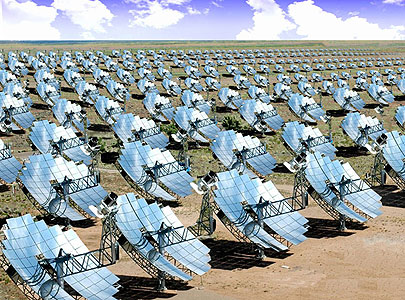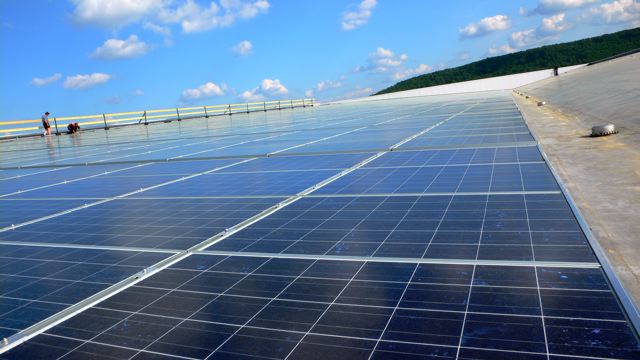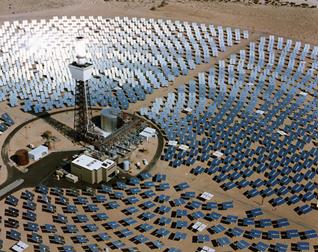|
|
|||||||||||||||||||||||||||||||
|
Solar Power becoming Profitable
Sun set to shine on solar profitsTyler Hamilton - August 27th 2007. The Cleantech Network released an insightful report last week that paints a rosy picture of the clean-technology sector, highlighting 2006 as a year of significant expansion. "The year 2006 proved to be even more exciting than 2005," the report states. "Total venture investment rose; M&A (mergers and acquisitions) and IPO (initial public offerings) remained robust; public policies gained clarity and purpose; and innovators showed they were up to the task of developing and marketing new and better ways to conserve natural resources." Among the highlights of the report is that investment in clean-tech companies rose 70 per cent, to $3.9 billion (U.S.) in 2006, with clean-energy-related investments such as solar and biofuels accounting for more than $3 billion of that. Amid all the hype – and the hype, at this point, may be justified – it's fair to ask whether all clean-tech investments are created equal. Some investors have strong views on this, including Vinod Khosla, founder of Khosla Ventures and a long-time partner with venture capital titan Kleiner Perkins Caufield & Byers (the firm that made early and successful bets on Google, Amazon.com and AOL). Khosla more or less divides clean-technology investments into two camps: those that can make real but relatively small changes and those that can make huge changes to the world's environmental problems, most notably climate change. "There's a difference between a good green investment and a climate solution," he told me last week in an interview. "I came into it from the point of view that asks what the large solutions are that actually matter to climate change. "I love PV (solar photovoltaics), and we have investments in PV, but I don't think it will be relevant to climate change in the next 20 years." Khosla is probably the closest you can get these days to a celebrity venture capitalist, and as a green investor with deep insight into emerging technologies and markets, he brings much-added balance to the debate – whether you agree with him or not. He calls conservation a "nice habit." He refers to hybrid cars as "great" but incremental. Biodiesel he considers "completely irrelevant." Solar PV is "sexy" but immaterial, partly because it's an intermittent source of energy, similar to wind. And while he sees an important role for new battery technologies, "to call that a climate change solution is an environmental hallucination. "I think we should stop playing with toys," says the self-described pragmatist, who never hesitates to engage in online debates with environmentalists and idealists who believe solar rooftops and wind power can wean us off coal. "If you're not solving 50 per cent of the problem it's not material." So what is a material "climate solution" in Khosla's world? What's clean, cost-competitive, can be deployed on a large scale and is capable of dramatically reducing greenhouse gas emissions? Khosla, in addition to his other green investments, is placing a big bet on solar-thermal technology – what he considers the best weapon in the "war on coal power generation." To a lesser extent, he's also increasingly drawn to the potential of enhanced geothermal power. "Solar thermal has been ignored completely in favour of sexier photovoltaics," he says. "When I started looking at solar thermal early last year, I couldn't find anybody who was paying attention, which sort of surprised me. It's a great technology, and about one-fourth the cost of PV with the kind of reliability that utilities actually like." Khosla says there are a number of utilities and investors pinning their hopes on clean-coal technology, which in one form is known as IGCC, or integrated gasification combined cycle. But IGCC, while cleaner than conventional coal, is expensive, unproven and risky. And that's ignoring the added cost of capturing the CO2 stream and sequestering it somewhere. "We can be cheaper than IGCC coal, even for our first (solar thermal) plants," says Khosla. "I'll beat them any day of the week on price, and I'll build them more quickly. I'll challenge anybody with this." I ask Khosla whether solar-thermal plants can be built anywhere. We know that just last week San Francisco-based Pacific Gas & Electric Co. signed a deal to purchase 553 megawatts of power from the Mojave Solar Park, a massive solar plant being built in the California desert. Can such plants help Ontario kick its coal habit? Khosla says the economics will differ depending on the geography – Arizona, it's safe to assume, is likely to be a better environment than Ontario, but it could technically be done anywhere in Canada. It all comes down to the cost per kilowatt-hour. This got Khosla talking about another important investment area: next-generation, ultra-high-voltage DC transmission technologies and infrastructure. In his mind, getting off coal and other fossil fuels means playing to our clean-energy strengths and connecting our energy sweet spots to a large, trans-national grid that can efficiently carry power over long distances.
Many environmental groups committed to renewable power are opposed to transmission expansion, because they feel it perpetuates the idea of big central power plants. They rightly see decentralized power as the future – solar PV on rooftops, community windmills and local co-generation stations that produce heat and power from biomass. All good, all necessary, but should this be to the exclusion of transmission? The thing about renewables is you take it where and when you can get it. The wind doesn't blow all the time, and it does so better in certain regions. The sun doesn't shine at night, and the days are longer the further south you go. Ocean and tidal energy is plentiful on the coasts. Geothermal heat can only be economically tapped in certain states and provinces. Biomass is plentiful but outside of major cities. Hydroelectric generation and pumped storage has tremendous potential, but most projects worth considering are too far from the current transmission system to be economical. If we truly want to tap the potential of renewables, we have to take a hard look at investing in transmission that allows a city like Toronto to benefit from wave power in Nova Scotia, solar thermal power in Florida, geothermal in British Columbia and hydropower flowing from Newfoundland. If we want renewables to directly replace coal and nuclear, it will only happen on the necessary scale if we have adequate transmission. Residential- and community-level renewables help reduce our need for the grid, but the need itself will never go away. "I think that (enhanced transmission) is absolutely key to all renewables," says Khosla. It's a sound argument, but one can also appreciate the reluctance of some environmentalists. They fear that big transmission will lead to big nuclear and coal, not big renewables. They believe the government will give priority to connecting the dirty spots, not the sweet spots. They also worry that a focus on big renewables will take emphasis and support away from small local renewable projects. In the hierarchy of fear, however, climate change should be on the top. Addressing it, and as quickly as possible, is a priority. And this is where Khosla, the pragmatist, may have it right.
Is this the power plant of the future?By solar thermal, Khosla Ventures' Vinod Khosla is referring more specifically to concentrating solar power, as opposed to solar thermal technologies used to provide space heating and hot water in buildings, or conventional solar power, where the sunlight strikes a PV cell and is converted into electricity. Concentrating solar power uses parabolic mirrors to focus the sun's energy on a single point, creating high temperatures that generate steam from a fluid. The steam spins a turbine, just as it would in a coal plant, which in turn generates electricity. Alternatively, the sunlight can be concentrated enough to heat and expand the gas in a Stirling engine to generate electricity (I encourage you to Google "Stirling engine" – very cool technology). Concentrating solar power is much more efficient than solar photovoltaic (PV), meaning it's way cheaper. It can be scaled up to several hundred megawatts, putting it in the same utility-scale class as coal and nuclear. It can be built faster, argues Khosla, and unlike PV it's not intermittent – heat that's generated during the day can be stored in rock, water, oil or as steam during the evening or when the sun isn't shining. That heat can be tapped to generate and dispatch electricity as needed, giving solar thermal the same baseload characteristics as nuclear and coal, but without the emissions or the radioactive waste.
|
|
||||||||||||||||||||||||||||||
|
Website Design + SEO by designSEO.ca ~ Owned + Edited by Suzanne MacNevin | |||||||||||||||||||||||||||||||


